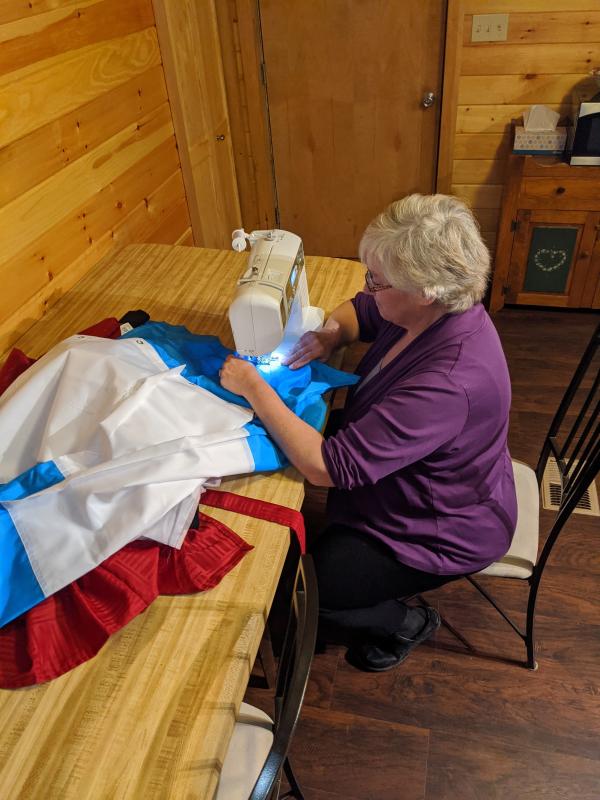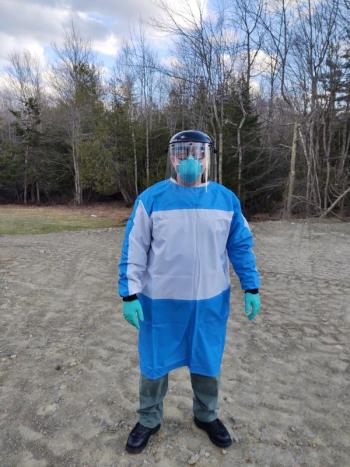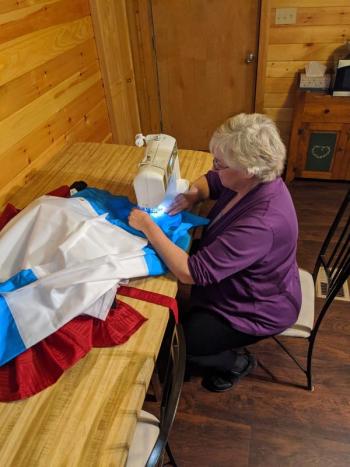Midcoast paramedics, EMTs brainstorm, sew their own PPE, using shower curtains and socks
 This is full protection for EMS personnel in days of COVID-19: A plastic face shield, durable and washable gown, gloves, N95 mask and (not seen in this photo) booties over the boots. (Photo courtesy Amy Dyer Drinkwater)
This is full protection for EMS personnel in days of COVID-19: A plastic face shield, durable and washable gown, gloves, N95 mask and (not seen in this photo) booties over the boots. (Photo courtesy Amy Dyer Drinkwater)
 Lynne Dyer, of Belfast, sews together a personal protection equipment gown, using a shower curtain, and special ribbed socks for the wrist cuffs. She is doing this as a volunteer effort to help keep ambulance crews safe as they render aid to sick COVID-19 patients needing transport to hospitals. (Photo courtesy Lynne Dyer)
Lynne Dyer, of Belfast, sews together a personal protection equipment gown, using a shower curtain, and special ribbed socks for the wrist cuffs. She is doing this as a volunteer effort to help keep ambulance crews safe as they render aid to sick COVID-19 patients needing transport to hospitals. (Photo courtesy Lynne Dyer)
 This is full protection for EMS personnel in days of COVID-19: A plastic face shield, durable and washable gown, gloves, N95 mask and (not seen in this photo) booties over the boots. (Photo courtesy Amy Dyer Drinkwater)
This is full protection for EMS personnel in days of COVID-19: A plastic face shield, durable and washable gown, gloves, N95 mask and (not seen in this photo) booties over the boots. (Photo courtesy Amy Dyer Drinkwater)
 Lynne Dyer, of Belfast, sews together a personal protection equipment gown, using a shower curtain, and special ribbed socks for the wrist cuffs. She is doing this as a volunteer effort to help keep ambulance crews safe as they render aid to sick COVID-19 patients needing transport to hospitals. (Photo courtesy Lynne Dyer)
Lynne Dyer, of Belfast, sews together a personal protection equipment gown, using a shower curtain, and special ribbed socks for the wrist cuffs. She is doing this as a volunteer effort to help keep ambulance crews safe as they render aid to sick COVID-19 patients needing transport to hospitals. (Photo courtesy Lynne Dyer)
ST. GEORGE — Paramedic Amy Dyer Drinkwater watched COVID-19 on the approach well before it gained a foothold in Maine. As the director of three ambulance services – St. George, Thomaston and South Thomaston – she had the safety of the community and staff to consider, and this particular risk was novel, not only in its pathology and virology, but in the way it skulked around, undetected.
As many knew from early on, medical personal protection equipment (PPE) — masks and gowns, face shields, even gloves and plastic booties — were in short supply. Maine, mostly rural and in the far corner of the country, had dim prospect of receiving much PPE from the national stockpile.
Photos from Wuhan and New York City, of nurses and doctors rushing among patients with their gloves, surgical masks, and thin yellow gowns, indicated what was to come for hospitals. Ambulance crews, often without even the gowns or masks, were loading stretchers from rigs into emergency rooms, in an endless stream. They were the ones going into homes where the air and surfaces were thick with COVID-19 particles, to rescue ill patients.
For their counterparts in Maine, it was a portent of things to come.
But, Mainers being Mainers, are used to making do with what’s available. They are resourceful and self-reliant, and don’t wait around for what might never materialize.
One night, Amy, along with her husband, Mike, himself a emergency medical technician, were deep in conversation about the PPE shortage. To Amy, it was imperative that her crews be safe.
A fundamental axiom of emergency medical care is that is that every responder must first ensure personal safety before rendering care to another human being.
“Ask yourselves, is the scene safe,” Amy will drill into the brains of her EMT students. But with invisible droplets from a ruthless virus, how do you begin to assess a patient who is short of breath, feverish, scared and needs help, and maintain personal safety?
“Prepare for the worst and hope for the best,” is Mike Drinkwater’s motto. His other one is, “adapt and overcome.”
So they did.
“Three weeks ago, we knew we weren't going to have enough PPE,” said Amy. “Mike had been to every hardware store between here and Augusta, looking for painter suits. There were none left.”
She went to to the federal CDC website, to the stark paragraph, “When No Gowns Are Available.” That’s on the page “Strategies to Optimize the Supply of PPE and Equipment,” where the federal government tells America’s healthcare workers: “PPE shortages are currently posing a tremendous challenge to the US healthcare system because of the COVID-19 pandemic. Healthcare facilities are having difficulty accessing the needed PPE and are having to identify alternate ways to provide patient care.”
Then she when to Fashion Girls for Humanity website and got the free pattern for making medical isolation gowns.
Fashion Girls for Humanity is a nonprofit founded by fashion industry leaders Julie Gilhart, Kikka Hanazawa, Miki Higasa, and Tomoko Ogura in the wake of the 2011 Japan Earthquake and Tsunami Disaster. It now extends humanitarian services and funds to communities in need through its network of fashion and design industry professionals.
Amy called her sister-in-law, Lynne Dyer, a hobbiest seamstress. A sewer since age 9, with 4-H, Lynne had been sewing cotton face masks for the community.
“Can you make gowns,” Amy asked her.
“What was she thinking,” Lynne Dyer said to herself. “Prom season has been cancelled.”
But Amy was thinking that Lynne might try the gown pattern using materials recommended by the Fashion Girls — polyester or polyester cotton.
Amy, Mike, Lynne and her husband, Paul, and Lynne’s mother, Ramona, put their heads together and the plan was hatched.
“Team effort,” said Amy.
She and Mike went to Ocean State Job Lots and bought shower curtains — blue and white ones, ones with flowers all over them — and Lynne got to work on her Brother sewing machine, “a plain one,” she said.
“The first gown was quite long,” she said. “Then, Amy said she wanted them to hit at the knee because they do a lot of kneeling on the ground with patients.”
The prototypes, “were terrible,” said Lynne. “Because of the slippage.”
But once she got her sewing machine adjusted and the stitch pattern established, it was production time.
A week later, and six were finished. By the end of the next week, 15 more were sewn. Paul Dyer is Lynne’s assistant. He cuts the panels of the gown so that Lynne can sew them together.
“My poor husband is very patient,” she said. “It has taken over our whole kitchen.”
The cuff, designed by Ramona, is made from the top of ribbed socks — a sturdy nylon blend, not cotton, and stretchy — and fits snugly at the wrists, but is comfortable enough to manipulate.
Crucial to the gown’s practicality is its durability to the washer and dryer. Every time an EMT or paramedic responds to a call with either confirmed or suspected COVID-19 presence, he or she puts on their PPE, all of it, in the ambulance, before even getting out in the driveway. That includes an N95 mask, face shield (like a welder’s shield), shower curtain gown, gloves, and plastic coverings for the boots.
“Home Depot gave us shields,” said Amy. “Both Lowes and Home Depot have been good to us. Back Cove Yachts gave Thomaston a lot of PPE, as did many other businesses and community members in each town.”
When they are done with each call, with the patient safely transported to the hospital, they will disrobe from the gowns, put them into a closed-tight bag, and take them to a washing machine, where they will be cleaned at a high temperature and then put into the dryer, again at high heat.
The shield will get wiped down with anti-virus cleanser, the gloves and booties thrown away. The N95 masks will get thrown away at the end of each shift.
It is a laborious process, but necessary, to stay safe while the virus continues its march across the globe.
Meanwhile, Lynne Dyer will continue to make the PPE gowns, eight for each of the three EMS services that Amy oversees.
After that, who knows. But she is happy to do the job.
“I love it,” she said. “I love the challenge.”
Reach Editorial Director Lynda Clancy at lyndaclancy@penybaypilot.com; 207-706-6657
Event Date
Address
United States


























